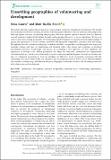Files in this item
Unsettling geographies of volunteering and development
Item metadata
| dc.contributor.author | Laurie, Nina | |
| dc.contributor.author | Baillie Smith, Matt | |
| dc.date.accessioned | 2017-08-31T23:32:21Z | |
| dc.date.available | 2017-08-31T23:32:21Z | |
| dc.date.issued | 2018-03 | |
| dc.identifier | 250454280 | |
| dc.identifier | 7d32c428-9de7-4499-b923-b1bd4b72e08c | |
| dc.identifier | 85041399599 | |
| dc.identifier | 000425746100007 | |
| dc.identifier.citation | Laurie , N & Baillie Smith , M 2018 , ' Unsettling geographies of volunteering and development ' , Transactions of the Institute of British Geographers , vol. 43 , no. 1 , pp. 95-109 . https://doi.org/10.1111/tran.12205 | en |
| dc.identifier.issn | 0020-2754 | |
| dc.identifier.other | ORCID: /0000-0003-0081-1404/work/64361340 | |
| dc.identifier.uri | https://hdl.handle.net/10023/11581 | |
| dc.description | Funding: UK AHRC (AH/G016461/1), ESRC (RES-451-26-0561). | en |
| dc.description.abstract | This article critically examines the geography of volunteering in relation to international development. We identify the investments involved in sustaining the North–South imaginaries that have come to dominate scholarship in this field and explore new ways of unsettling this geography. We draw together empirical material from five different research projects, conducted with distinct thematic and geographical foci over a six-year timeframe. We do so in order to show how existing geographies of volunteering and development have produced fixed understandings of agency and experiences in diverse contexts, meanwhile side-lining the temporalities associated with such fixings. We highlight how the continued privileging of northern mobilities, temporalities and biographies has segregated particular settings and types of volunteering and obscured other, often shared and sometimes co-produced development processes, relationships and spaces. In developing a new approach, we first emphasise the importance of looking at the ‘hidden geometries’ that shape the individual, institutional and organisational articulations that are central to the relationship between volunteering and development. Second, we introduce the idea of a flattened topography to level the emphasis on difference in the geographies associated with this relationship. We aim to make visible new volunteers and development actors as well as reveal different rhythms and routines of volunteering, and different identities, biographies and forms of career and life-making connected with volunteering and development. | |
| dc.format.extent | 15 | |
| dc.format.extent | 174654 | |
| dc.language.iso | eng | |
| dc.relation.ispartof | Transactions of the Institute of British Geographers | en |
| dc.subject | International development | en |
| dc.subject | Flattened topographies | en |
| dc.subject | Relational space | en |
| dc.subject | Volunteering | en |
| dc.subject | Temporalities | en |
| dc.subject | Biographies | en |
| dc.subject | G Geography (General) | en |
| dc.subject | HT Communities. Classes. Races | en |
| dc.subject | NDAS | en |
| dc.subject | BDC | en |
| dc.subject | R2C | en |
| dc.subject.lcc | G1 | en |
| dc.subject.lcc | HT | en |
| dc.title | Unsettling geographies of volunteering and development | en |
| dc.type | Journal article | en |
| dc.contributor.institution | University of St Andrews. School of Geography & Sustainable Development | en |
| dc.identifier.doi | 10.1111/tran.12205 | |
| dc.description.status | Peer reviewed | en |
| dc.date.embargoedUntil | 2017-08-31 |
This item appears in the following Collection(s)
Items in the St Andrews Research Repository are protected by copyright, with all rights reserved, unless otherwise indicated.

